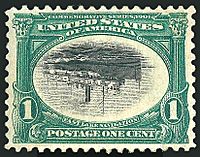Pan-American invert facts for kids
Quick facts for kids Pan-American invert |
|
|---|---|

Inverted one cent denomination
|
|
| Country of production | United States |
| Date of production | May 1, 1901 |
| Nature of rarity | Invert error |
| Face value | 1¢, 2¢ and 4¢ |
| Estimated value | US $$100,000 |
Imagine a stamp where the main picture is upside down! That's what happened with some special stamps made in 1901 for the Pan-American Exposition in Buffalo, New York. The United States Post Office Department created a set of six stamps to celebrate this big event. Each stamp had a colorful border and a black-and-white picture of new ways to travel, like trains or ships.
These stamps are known in stamp collecting books as numbers 294-299. They were first sold on May 1, 1901.
Contents
What Are Pan-American Invert Stamps?
The Pan-American stamps were printed using two different colors. This meant the frame was printed in one color, and the central picture (called a "vignette") was printed in another. When printing with two colors, sometimes mistakes can happen.
The "Upside-Down" Error
A rare printing mistake happened with three of these stamps: the 1 cent, 2 cents, and 4 cents values. On some sheets, the central picture was printed upside down compared to the frame! These upside-down stamps are called "inverts." They are listed in stamp catalogs as 294a, 295a, and 296a.
The Mystery of the 4-Cent Invert
The 1 cent and 2 cent upside-down stamps were accidentally sold to the public. However, the 4 cent invert stamp has a very interesting story. It was actually printed on purpose, but because of a misunderstanding!
After the first upside-down stamps were found, a postal official wanted to find any other errors. He asked the printing office to send him any inverted Pan-American stamps they had. The printing office didn't have any left. But instead of saying so, they thought they *had* to send some. So, they printed 400 new 4 cent upside-down stamps!
About half of these new stamps were marked with the word "specimen" in purple ink. The postal official gave many of these stamps away as gifts. Later, there was an investigation, but he was cleared of any wrongdoing because no money was involved. Some of these stamps ended up in a government collection. The person in charge of that collection even traded some of them for other rare stamps the museum needed.
How Rare and Valuable Are They?
The 1 cent upside-down stamp is more common than the others. Still, all these invert stamps are very rare and valuable. A set of all three (1 cent, 2 cents, and 4 cents) is estimated to be worth around $100,000!
In 2009, some of these stamps were sold at an auction for a lot of money. A single 1 cent invert sold for $19,000. A 2 cent invert and a 4 cent invert each sold for $90,000! Even more amazing, a block of four of each invert stamp sold for over a million dollars! Stamps marked "specimen" are usually worth less than those without the mark.
Celebrating the Inverts: The 2001 Stamps
In 2001, exactly 100 years after the original stamps, the United States Postal Service made a special sheet of stamps to celebrate the Pan-American inverts. This "souvenir sheet" included copies of the three original upside-down stamps. It also had four new 80-cent stamps. These new stamps were based on a special "Cinderella stamp" (a stamp-like label not used for postage) from the original 1901 exposition.
The new stamps looked very much like the old ones, but they had the year "2001" printed in the corner. Millions of these souvenir sheets were printed, so they are quite common today.

